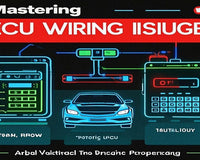
Most tuning companies offer their remapping service in 4 different levels, which are called tuning stages. In each of these four stages, specific changes are made to the various car parameter tables.
Stage 1 Tuning: This is often the most basic level of tuning, focusing on simple modifications that can be done without extensive mechanical changes. Common upgrades include:
1. ECU remapping or car chip tuning to optimize engine performance.
2. Upgrading the air intake system for better airflow.
3. Installing a performance exhaust system to improve exhaust flow.
What tools are available for ECU remapping?
KESS3: This is a versatile tool that supports OBD, Bench, and Boot modes for ECU programming. It is designed for ease of use and high performance, making it suitable for various vehicles including cars, bikes, and trucks. KESS3 is known for its fast processing and user-friendly interface.

PCMtuner Programmer: This tool allows for advanced ECU programming and supports various protocols including JTAG and Bootloader. It is designed to handle complex tasks such as ECU cloning and TCU programming.

SM2 PRO J2534 VCI: Known for its speed and stability, this tool supports multiple programming methods including OBD and Bench. It is particularly effective with European vehicles and offers a complete tuning solution.

After “Stage 1 Tuning" or remapping, the performance of the vehicle will typically improve. The engine's power and torque output will increase, resulting in faster acceleration and improved overall drivability. Additionally, fuel efficiency may also improve slightly due to the optimized tune.
Stage 2 Tuning: This stage involves more significant modifications that may require additional hardware changes. It typically includes:
1. Turbocharger or Supercharger Installation: Adding forced induction systems to significantly boost power output.
2. Upgraded Fuel Injectors: Analyze vehicle fuel consumption with the FNIRSI FD10 OBD2 car code reader, upgrade fuel efficiency, and increase fuel demand due to enhanced intake and turbocharging.
3. Enhanced Cooling Systems: Installing intercoolers or upgraded radiators to manage increased heat from performance enhancements.

Stage 3 Tuning: This is an advanced level of tuning that often requires extensive modifications and may involve:
1. Internal Engine Modifications: Upgrading components like pistons, camshafts, and connecting rods for higher durability and performance.
2. Full Exhaust System Replacement: Including headers and high-performance catalytic converters for optimal exhaust flow.
3. Suspension Upgrades: To handle increased power and improve handling characteristics.
Stage 4 and Beyond: These stages are typically reserved for race applications or extreme performance builds, involving:
1. Custom Engine Builds: Creating a bespoke engine setup tailored for maximum performance.
2. Weight Reduction Techniques: Removing unnecessary components or using lightweight materials to enhance speed and handling.
3. Advanced Aerodynamics: Adding body kits, spoilers, and diffusers to improve downforce and stability at high speeds.

Each stage of tuning not only enhances power but also affects other aspects of vehicle dynamics such as handling, braking, and overall driving experience. For instance, while Stage 1 might improve throttle response and fuel efficiency, Stage 3 could lead to significant increases in horsepower but may require corresponding upgrades in braking systems to ensure safety at higher speeds. Each stage is designed to progressively increase the car's capabilities, allowing enthusiasts to tailor their vehicles to specific performance goals.










